#Terry Fox who had cancer raised money by running across Canada
Text
Hundreds of Maritimers attend Terry Fox Run in-person for first time in two years
Following two years of cancellations due to the ongoing COVID-19 pandemic, one of the country's best-known cancer fundraisers was back bigger than ever this past weekend.
The Terry Fox Run attracted hundreds to Point Pleasant Park in Halifax, where 200 runners were on their feet by 9 a.m. Sunday.
Not only were there hundreds of participants, but plenty of family-friendly activities also saw people on-site for most of the day.
Organizers and participants say they were pleased to see such a great turnout.
"I think in the past few years, cancer research has taken a step back to other illnesses that have been in the news a lot more. So, it shows people that there's still a lot of support for this cause and allows them to kind of feel like a community in supporting this," says Marie-Claire Wasson, an organizer of the Halifax Terry Fox Run.
"It makes a big difference because I learned that the same diagnosis I had 23 years ago no longer required chemotherapy and that's in part because of cancer research," said participant Trent Robinson.
Organizers of the Halifax run say they'll continue raising and collecting funds for the cause, and they expect the numbers will increase as time goes on.
Several other Terry Fox Runs took place in Nova Scotia Sunday, including in Sydney, where runners started their five-kilometre race at the Victoria Park Armories.
One of the Sydney run’s organizers, Steve MacNeil, says they were able to surpass their fundraising goal before runners even laced up their shoes.
"We had set a goal of $7,000 for the Sydney run site, and we cleared that before we even arrived today," said MacNeil during Sunday's event. "So, whatever money we've accumulated today will go on top of that total, and yeah, who knows how far we'll take it this year."
Donations towards the Sydney Terry Fox Run are still being accepted online.
Runners also gathered in Lake Echo, N.S., Sunday. Organizers say they were pleased with the event.
"It's really humbling to see the community come together on a rainy day to contribute and to carry on Terry's dream," said Melanie Coombs, chair of the Lake Echo Terry Fox Run.
In Charlottetown, dozens gathered at the University of Prince Edward Island for the start of the run.
Reilly Sullivan, a fourth-year biology student and a member of the university's women's basketball team, helped organize the Charlottetown race. She says she's been participating in Terry Fox Runs since the age of 12, and is a second-generation organizer.
"It's been a big family thing for me. My family's friend used to come out, so for me, to be able to take on this role, it means a lot to me and in a personal sense," said Sullivan. "But just being able to organize an event that raises funds for cancer is super important."
Terry Fox Runs also took place across New Brunswick, including in Fredericton, Saint John and Moncton.
Terry Fox was 18 when he was diagnosed with osteogenic sarcoma just above the knee. His leg had to be amputated as a result.
On April 12, 1980, Fox began his run, known as the Marathon of Hope, across Canada.
Starting in St. John's, N.L., he ran close to 42 kilometres a day, morning to night, through the Atlantic provinces, Quebec and Ontario, stopping in hundreds of towns, schools and cities along the way.
On Sept. 1, after 143 days and 5,373 kilometres, Fox was forced to stop outside of Thunder Bay, Ont., after cancer appeared in his lungs.
He died on June 28, 1981, at only 22 years old.
His inspiring story has led to annual Terry Fox Runs in more than 60 countries.
To date, over $850 million has been raised for cancer research in Terry’s name through the annual Terry Fox Run, held across Canada and around the world.
from CTV News - Atlantic https://ift.tt/B4jszTK
0 notes
Text
Do people outside of Canada know who Terry Fox is? I recently learned that Terry fox day is only really done in Canada which is mind blowing to me because who wouldn’t want to raise money for cancer?!
#Terry Fox#Terry Fox day#Terry Fox Run#Cancer#Terry Fox who had cancer raised money by running across Canada#He had a leg amputated because of his cancer and then continued to run his marathon#He died at 22 and was not able to finish his run#every year schools across Canada have a day where every student runs a marathon for cancer awareness#Students wear stickers that say I'm running for...#They can put the name of a loved one with cancer or Terry Fox himself or just write cancer#The whole week students will bring in money to get donated to cancer research#Schools normally earn thousands of dollars every year through student donations#In the 30 years since he's died there's been over 800 million dollars raised in his name#Imagine how much faster cancer would be cured if every country did this
3 notes
·
View notes
Note
the whole continent of north america is strange to me
youve got me confused and invested in this situation now
ok let me try and sum this whole situation up really quickly for those confused AJDHSJ
basically, there's currently this protest in canada called "the freedom convoy" where a bunch of truckers (and conservatives) have decided to drive to canada's capital city in order to protest the vaccine mandate that was put in place (as well as other covid mandates)
they pretty much drove from west canada to the capital and while doing that raised over 7 MILLION FUCKING DOLLARS????
when they arrived in the capital, they ended up defacing the terry fox statue thats there. terry fox is a canadian hero who attempted to run across canada to raise awareness and money for cancer research after he had to had his leg amputated due to cancer when he was 18. (unfortunately, he ended up dying of cancer before he could finish his marathon and the statue was built in his honor)
so, tl;dr: antivax truckers defaced a statue of a canadian hero, whose whole campaign was him trying to raise money for cancer research
#kr talks#ask#king-of-the-pillow-fort#i try not to talk abt politics stuff on here bc. it can get pretty upsetting for everyone involved#but#i think we can all agree that this was fucking stupid
19 notes
·
View notes
Photo

Forty years ago today, on a stretch of road near Thunder Bay, Ont., Terry Fox felt an intense pain in his chest.
He’d already run almost 42 kilometres every day for more than four months in his ambitious cross-country mission to raise money for cancer research. But by kilometre 5,373, the cancer he’d been fighting spread to his lungs, and he was forced to stop running.
Sept. 1, 1980 marked the last day of the Marathon of Hope. Fox died in hospital the following summer at the age of 22.
His older brother, Fred Fox, said that, for him, today is a day for reflection.
“It was people lined up along the road that kept him going,” Fred told CTV News Channel on Tuesday from Maple Ridge, B.C. “But he realized that he had to get to the hospital.”
While today marks the anniversary of a sad ending, Fred said it also represents a hopeful new beginning: the moment Terry passed the torch to his fellow Canadians to continue the mission he started.
“Here we are 40 years later, and Terry’s sacrifice, what he did in trying to make a difference and raising funds for cancer research, has impacted the lives of so many people,” he said.
After Terry was diagnosed with bone cancer at the age of 18, he had his right leg amputated above the knee. The idea to run across Canada for cancer research came to him while he was recovering in hospital.
Fred recalled the moment Terry told the family that he planned to run across Canada. Terry had recently run a race in Prince George, B.C., where he was the only amputee. He finished last and returned home to break the news to his mother.
“Mum was upset, protective mum,” Fred said. “(She) told him he was crazy, said ‘Why don’t you just run through B.C. to raise money that way.’ And Terry said, ‘Mum, not only people in B.C. get cancer, but people right across Canada.’”
After that, the whole family got on board and supported Terry throughout his journey, even joining him for various segments of the run.
Terry’s original goal was to raise $1 for every Canadian — $24.17 million — which was achieved just four months before his death. Since then, more than $800 million has been raised to support cancer research in Terry’s name.
Fred said his brother would never have believed that, 40 years later, his legacy has left an indelible mark on Canada.
“Terry only hoped that his example of never giving up and the example of caring for other people would be carried by other people,” he said.
“He would be so proud that maybe his inspiration, what he did, has inspired so many to continue what he started.”
On Sept. 20, a virtual Terry Fox run will be held across Canada. Participants are invited to collect pledges and then embark on their own non-competitive run or walk in their community. Nearly 10,000 runners have already raised almost $1 million for this year’s event.
Prime Minister Justin Trudeau issued a statement Tuesday calling Fox “a Canadian hero who taught us invaluable lessons about the importance of helping others.”
"His extraordinary accomplishments captivated the country, instilled hope in Canadians, and helped shift their views of people with disabilities. Forty years later, people across Canada and around the world continue to be inspired by Terry’s tenacity and enthusiastic message of hope, which is as timely as ever during the COVID-19 pandemic,” Trudeau said.
Daily inspiration. Discover more photos at http://justforbooks.tumblr.com
38 notes
·
View notes
Text
Jayne Torvill and Christopher Dean: 10/7/57 and 7/26/58
1984 Olympic gold medalists who brought attention to the relatively new sport of ice dance (it had been an Olympic medal sport since 1976). Also won bronze in the 1994 Olympics, 4x World, 4x European and 7x British champions. Head judges on Dancing on Ice on British tv since 2018. He has choreographed programs for many skaters including Michelle Kwan, Papadakis/Cizeron, and Gilles/Poirier.

Jayne Torvill is a Libra with moon in either Pisces or Aries. A stellium of planets in Libra gives her strong energy from that sign. She’s sociable and learns from relating to others. Wants peace and harmony (though if her moon is Aries, she would be more assertive), a good partner, a team player.
She has a Cradle pattern in her chart which makes her active, independent and somewhat extroverted. A Cradle is made up of all easy aspects connecting to one challenging one- in this case Uranus opposite Chiron: desire to break limitations and stand out in a crowd. anxiety and impatience that are destabilizing. feeling like you don’t fit or belong (Tessa has this aspect in her chart too)
The other aspects are supportive and ease this energy: Sun conjunct Jupiter: an enthusiastic and optimistic outlook which allows one to accomplish a lot. Generous and resourceful. Sun, Mars, and Jupiter:
all trine Chiron: gravitates towards the arts, makes peace with her vulnerabilities, a worldview enriched by compassion.
all sextile Saturn: responsible, doesn’t make a fuss about herself. dry sense of humor, strong work ethic with endurance. patience and caution masks passion and ambition to accomplish long term goals
all sextile Uranus: healthy ego, proud to be different, forthright with opinions, high energy, independent. strong presence
Saturn trine Uranus: good at finding freedom to be herself within the system and rules. able to innovate and express creativity without rocking the boat
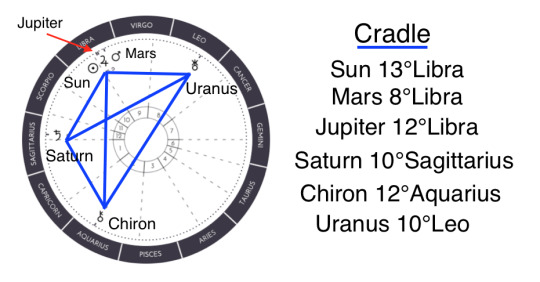
Christopher Dean is a Leo with moon in Capricorn: Purposeful, with an inner core of resolve and hardness, maybe less sociable than most Leos. Upbeat, cheerful public face. Great willpower and ambition, his reputation is very important to him.
Mercury conjunct Pluto: intense mind, wants to look beneath surface of things. strong and fixed opinions and beliefs. tendency to hold a grudge and settle scores. Demanding in personal relationships.
He has a pattern in his chart which shows creativity and sensitivity but also anger and energy to battle - a T-square with Mars opposite Neptune, both square Sun: the Sun and Mars are both about ego and will and drive. these are in a tense pattern with Neptune, which is compassion, art, dreams, illusions. A career in a competitive artistic sport fits the inspiration and drive in this combination of energies.
He has a Thor’s Hammer with Sun square Mars, both sesquiquadrate Saturn.This is a really tense pattern that’s difficult to live with, as the hard aspects continuously demand attention. People who have them are characterized by incredibly dogged persistence and a need to prove themselves. They feel compelled to solve the boiling tension through trial and error. (Scott and Tessa each have one too: x x )
Sun square Mars: tension and fighting energy that needs to be spent in action like sports. boiling anger needs to be managed. needs to be doing something all the time. fiery willpower and competitive spirit.
Sun sesquiquadrate Saturn: strong work ethic, a lot of frustration when younger that is gradually solved through patience and perseverance.
Mars sesquiquadrate Saturn: drive and ambition that sometimes throws caution to the wind
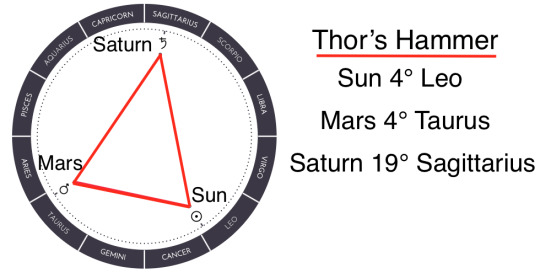
Christopher Dean was born on the same day as Terry Fox, the Canadian athlete and national hero who lost a leg to cancer and is celebrated for running across Canada to raise money and awareness for cancer research. They each have this Thor’s Hammer in the same degrees. The persistence and determination that drove Terry Fox to run for 143 days and 5373 km also is in Christopher Dean’s chart.

Torvill and Dean relationship chart: during their competitive career, they were known for their chemistry on the ice and for elevating the sport.
Composite Mercury conjunct Venus: strong shared sense of aesthetic appreciation. easy to express affection - helps smooth any roughness in the relationship. sensitivity to each other’s feelings
Composite Mercury and Venus square Saturn: need to make a conscious effort to communicate effectively, or negative thinking will cause problems. can block a romantic relationship, but with managed expectations, friendship or business relationship can work well.
Composite Mars square Jupiter: great deal of active energy between you, enjoy doing things together. underlying dynamic of friendly competition that can be beneficial when channeled towards a common goal. can achieve more together than individually

8 notes
·
View notes
Text
Today is a soul crushing day for me. First off: Today is Orange Shirt Day. For those of you who don’t know, Orange Shirt Day is a day of remembrance for Canadian residential schools, their survivors, and their lasting effects on the First Nations people of Canada. We learn about the abuse, suffering, and all the horrible things that the Canadian government did for so many years, destroying cultures and permanently damaging all those affected.
A few days ago was Terry Fox Day. For those who do not know: Terry Fox was a sufferer of osteogenic sarcoma (bone cancer) who had to have his leg amputated. He planned to run across Canada, from sea to sea, raising money for cancer research, a dollar for every Canadian, on a prosthetic leg. Unfortunately, his trip was cut short, as cancer developed in his lungs. Every year, schoolchildren across the country run and raise money in his memory in support of cancer research. This always hits hard for a few days afterward, as my younger sibling is a cancer survivor themself.
And then there’s the pandemic and all of the other disasters going on. To all Americans who might see this: I am so, so sorry for what you are going through. I wish so desperately that I could help. I have lived through times when wildfires burned nearby, and I know how terrible it is. I watched the last 20 minutes of the debate last night, and it hurt. I cannot imagine how painful it must be for all of you. It’s hard to keep hope going in a time like this, and I am very close to letting it escape. But I will not. I have to keep going, and I have to stand strong, because it is up to us to recognize all of this and help. Even so, it’s okay to feel hopeless. It’s okay to be stressed, and it’s okay to hate the world. We are living in a terrible time, and nothing can take away from that. Please keep yourself safe, and please do your best to keep going. Things will improve, I promise.
1 note
·
View note
Video
vimeo
Theology 640 Week 4 Video
Here's a list of what I used and the reason why:
The Best Years of Our Lives (1946) - World War II movie about soldiers returning home from the war, particularly one man who lost his hands in an explosion and now has to learn to readjust, but overcomes his disability to become productive to society and ultimately marry his sweetheart.
Raising Arizona (1987) - Comedy about a couple who decide to kidnap a baby from a local millionaire who just had quintuplets since they cannot conceive a child. Thought this was a good contrast to the IVF / abortion aspect of this week's lesson.
Ray (2004) - Bio-pic of singer Ray Charles who overcame early onset blindness to become one of the world's top music artists. Category: Handicap
Shine (1996) - Another musical bio-pic of classical pianist David Helfgott who suffered a mental / nervous breakdown and spent his life in and out of institutions before overcoming this to become a publicly respected performer. Category: Mental illness
Finding Neverland (2004) - Story of a widowed mother raising four boys who soon learns she herself is dying but befriends the author J.M. Barrie who wrote the children's tale "Peter Pan". Category : Widows and orphans
It's Kind of a Funny Story (2010) - Movie about two teens who meet in a mental institution while dealing with suicide and depression who happen to fall in love. Category: Suicide
The Miracle Worker (1962) - Bio-pic about Helen Keller who was born blind and deaf but who overcame her handicap. Category: Special Needs
The Theory of Everything (2014) - Bio-pic about world renowned physicist Stephen Hawking who continued a successful career despite being diagnosed with ALS. Category: Handicap
Oliver! (1968) - Musical adaptation of Charles Dickens' "Oliver Twist" in which orphans struggle on the streets of London as petty thieves, while Oliver just desires a stable home. Category: Orphans
City Lights (1931) - Charlie Chaplin comedy about the little tramp falling in love with a blind street flower peddler who he attempts to procure funds for so she can have an operation to restore her eyesight. However, she mistakes the charity as coming from a local millionaire. Category: Special needs / disability
The Terry Fox Story (1983) - True life story of a man who lost his leg to cancer and then set out to run across Canada on his artificial limb to raise money for cancer research. Category: Handicap
Witness (1985) - Drama about an Amish boy who witnesses a murder and is protected by his widowed mother and a gruff police detective as the killers come after the child. Category: Widows
Forrest Gump (1994) - Fantastical tale of a man who lived through many of the key moments of the 20th century and his friendship with the lieutenant he served with in Vietnam. Forrest Gump saves Lieutenant Dan but the lieutenant has lost both his legs and is distraught / suicidal. Forrest tries to restore him to life which ultimately leads to a life-changing confrontation with God. Category: Disability
Free Willy (1993) - Family film about a young orphan who befriends a killer whale at a local sea aquarium while trying to get the creature to freedom. Category: Orphans
Mr. Holland's Opus (1995) - Story of a classically trained musician who foregoes his dream of being a great symphony conductor / composer when his family runs into financial hardship and who takes on a job as a high school music teacher. On top of this, he learns that his new son is virtually deaf and will likely never hear the music he loves. Category: Disability
It's A Wonderful Life (1947) - Classic Christmas movie about a man who's life is falling apart and who contemplates suicide until a wingless angel named Clarence shows him what the world would be like without his presence. Category: Suicide / Depression
Indiana Jones and the Temple of Doom (1984) - Adventure film in which children of a local Indian village are kidnapped and forced into slave labor by a sadistic cult but who are saved by a swashbuckling archaeologist, his love interest and a young protege. Category: Orphans / Slavery
The Passion of the Christ (2004) - Thought it would be fitting to finish with the Resurrection sequence from the film about the Passion of Jesus who ultimately overcomes death itself. Category: Culture of Death
1 note
·
View note
Link
I write this post to be a reminder and a little kick in the derriere to my Canadian followers who can run tomorrow, but I don’t require anyone to donate by any means! There are 4000 of you so there’s no reason not to post the link on my blog.
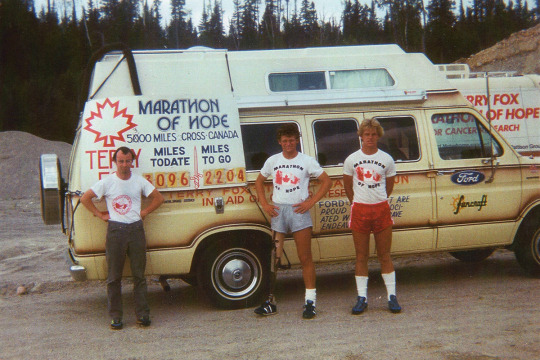
If you’re Canadian you know this story like the back of your hand, but to the uninitiated - Terry Fox was a 22 year old who lost his leg to cancer and began a run across Canada to raise money for cancer research. Don’t let his big smiles in pictures fool you - this was exhausting and painful, especially for someone who was already suffering.
Terry set out to change the world with the full knowledge that he might never finish his run (indeed 143 days in he had to stop when the cancer had spread to his lungs. he died shortly before his 23rd birthday.) Terry was not superhuman, he was not a superb athlete to whom success came easily - rather he trained, played, and practiced constantly to win a spot on his high school basketball team, and later to run across Canada, despite advice that he would live longer if he gave up the idea.

That kind of affection and determination feels rare when it's all too easy to seek immediate gratification - to want to be the best immediately or to give up. Terry was bright, loving, talented, and brave, and it's a privilege to keep fighting his fight in the smallest of ways. The fight against cancer is one that benefits all of us. If you’re Canadian I encourage you to run tomorrow, and if not, to donate somewhere. You can sponsor my own run at the link above or visit terryfox.org.
9 notes
·
View notes
Text
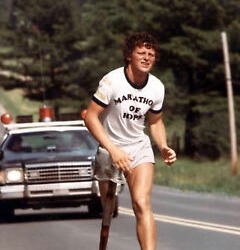
Today the staff and students of St. Matthew participated in our annual Terry Fox walk in honour of a remarkable Canadian who had big aspirations. Despite losing his leg to cancer, Terry Fox set out to run across Canada and raise money for a cure. Sadly, he did not accomplish his goal. But 38 years later, millions of Canadians continue to walk for him. Thank you to everyone that participated in today’s walk, and to those that generously donated to this wonderful cause!
2 notes
·
View notes
Text
The mayor of the hometown is among those venting anger after the statue of Terry Fox was covered with political statements during a rally opposing COVID-19 measures. West told Global that the attempt to appropriate his legacy and his image for a cause is "just sickening."
Photos from the rally showed the statue holding a flag and holding a sign reading "mandate freedom."
After Watson told city staff to remove the items, new images appeared on social media showing the statue holding a sign. Amputee Fox, a cancer patient, was born in Winnipeg but raised in Port Coquitlam, B.C. He became a national icon when he ran across Canada in 1980 to raise money for cancer research.
In 1981, Fox succumbed to cancer before completing his journey, but he became a national inspiration. He raised thousands of dollars for cancer research. "No one should ever take the feelings and try to use them for political purposes," West said, adding that Fox was a unifier who should not be politicized.
This is disgusting, it's wrong, and it's not meant to work. I think whoever thought this was an idea did not think it through. If I lived closer to Ottawa, I would drive my truck over to the statue tear it down myself, West added.
In condemning the appropriation of the statue, West wasn't the only one. In social media, thousands of Canadians complained that their cancer treatments had been delayed after provinces cancelled surgeries due to COVID-19 pressure on hospitals.
"As our hospitals treat the unvaccinated, Fox sacrificed everything for people with cancer. This is shameful since there are thousands of people without access to cancer treatments," Boozary tweeted.
Currently serving as national vice-chair of the Society, Moore described the actions as 'disrespectful.' "Fox died of cancer he exacerbated while running across Canada to raise money to fight a deadly disease - quite the opposite of what’s happening here," Moore wrote.
"Do your thing, have a protest but don't disgrace the statue." The Fox Foundation also took to Twitter Saturday, posting a photo of the statue in its state and writing about the legacy without mentioning Fox.
The rally on Saturday was the culmination of a convoy started in opposition to eliminating exemptions for truckers. Many have called for the end of all measures and for the removal of the government at the rally, which drew thousands of people to Ottawa.
0 notes
Text
Tourist guide to Victoria BC
This weekend we headed to the foreign land of Canada! We have ventured to Vancouver before, but we went a little bit further this time out to Vancouver Island aka Victoria, BC!
Friday night we drove across the border and missed the ferry by about a half hour. We hadn’t planned to cross the border that night but went for it. Without a place to stay we were stuck with car-camping at Walmart. We referenced our own guide for free camping, which you can find here!

Peace out Vancouver, hello Victoria!
Day 1
We hopped on the Tsawwassen ferry in Vancouver to head over to Victoria (plan your ferry trip here). We shared a bench-seat with Adorillia, a retired Brazilian living in Canada for a few months studying English!
Once our ferry made it to the island we drove aimlessly until we hit Fisherman’s Wharf. This is definitely a must see. There are docks lined with shops and restaurants and even…a neighborhood! Between a few of the restaurants, there were a couple of harbor seals hanging around catching some rays on their bellies.

We want a floating house now…
We decided to grab a quick bite to eat and quickly realized how walkable Victoria is. On our way to a restaurant we passed our hotel, and many of the stops we had marked on our map. The town is relatively flat, full of old architecture, and definitely one of our favorites. The locals are very friendly making it easy to strike up a conversation.
We heard Beacon Hill was a beautiful park with a statue of the one and only Terry Fox! If you haven’t heard of him he is an amputee who embarked on an east to west trans-Canada run to raise money and awareness for cancer research! We walked through what is a gorgeous park that runs along the shore of the Juan de Fuca Strait. And it has an off-leash dog park, so be prepared to pet all the cute pups! We couldn’t find the statue, but we did find tons of peacocks?! No one thought it necessary to mention the park is sprawling with peacocks! What a sight to see!

Peacocks in the park!
we came for beers and left with new friends
That evening we headed to a bar to grab a drink before dinner. While we were enjoying our happy hour beverage we began to talk with a man at the bar who slyly asked if we recommended the bruschetta…he ended up being the head chef of the joint and got us free food! After he left, a Brazilian couple sat down, and we ended up talking to them for hours. When we made motion to leave the bar tender let us know we had stayed long enough for their late-night menu and got more discounted food and drinks! Literally, we were at this bar for 5 hours haha we came for beers and left with new friends and lots of knowledge of Brazil and Victoria.
Day 2
On Sunday we had big plans to hike East Sooke Park. We wanted to hit up Goldstream Provincial Park on our way in order to see the Trestle Bridge. Before you hit the trestle you get to hike alongside Niagra Falls (Victoria’s version) and then up over the top of it.

Niagra Falls (Vancouver Island’s version)
Goldstream Trestle is a must see! The pictures don’t do it justice. Until you walk across those slippery beams yourself peeking through at the rushing water hundreds of feet below you, you have not experienced it!

Taking it all in
At the first trestle, we met a couple of hikers who told us about a tunnel carved out of the mountain. They said they had never seen it themselves, but that it was only a half an hour further down the trail. We decided to check it out. We arrived at another trestle that was just as magnificent as the first. We kept walking, and walking…about 50 minutes later we came upon a tunnel. It was beautiful! Not a half hour away, but well worth the journey.

Pretty cool, pretty cool
On our way back to the car we took note of just how soaking wet we were. We had worn rain gear, but we were drenched to the bone. We had hiked quite a bit further than we planned and did NOT plan on being so wet so early into our day. We decided to head back to Victoria for some coffee and soup! Victoria has lots of cute coffee shops for those coffee connoisseurs, like us, out there.
Best fish, but bad rice makes shitty sushi
For dinner, we decided to find a sushi joint. Yelp is filled with tons of sushi places for Victoria. We scrolled and pointed. We ended up at Omakase! Omakase is a term meaning, “a meal consisting of dishes selected by the chef“. The chef will speak with you and figure out what you should eat based on his conversation with you. It can cost anywhere from $60-$200. We spoke with the chef, but opted out of this option haha. After talking with him and the other people at the bar, they talked us into it…so next time we’ll do it!

Omakase sashimi
We sat at the bar so that we could watch the chef prepare the sushi (we make our own and still suck at it). While chatting with the chef we were able to experience how his career is his passion. He was proud of the food he serves and the time he put into selecting the best fish, and the best rice. Medi, the chef said “Best fish, but bad rice makes shitty sushi”. When we tried ours we knew what he meant. We eat a lot of sushi…a lot! But this was by far the best we’ve ever had. The seafood just melted on your tongue, and the rice was almost a paste instead of grain. It was amazing! We still have dreams of the unagi…
We walked around Victoria’s Chinatown, which is the oldest Chinatown in Canada! They are also known for having the most narrow alley, Fan Tan Alley. We walked down main street Chinatown and found Fan Tan! It was a beautifully decorated alleyway with little shops set up along it!

The narrowest alley in Victoria, Fan Tan Alley!
Day 3
On Monday we knew we had to head back home but figured we’d make use of the weekday hours. We decided to take a tour of the parliament building during its open hours. We learned a lot about Canadian politics and the history of the island. I think we now know more about Canadian politics than US…which isn’t saying much.

Gorgeous architecture of the Parliament building
Before we headed home we did one more loop of Beacon Hill Park to try to spot Terry Fox. We found him!! He is positioned in a loop on a running trail, how fitting! There is a great documentary on his journey here (episode 17).

We found the monument!
On our way home, we often procrastinate our arrival. We will literally point anything out on the road to stop and look at. On our way home from Kentucky we stopped at a fudge shop (you can read about that here). This time we didn’t need an excuse…Hundreds of bald eagles were flying over us! Never in our lives had we seen this many eagles…we’ll definitely be back for some photo ops!
We got our feet wet over the weekend for what Victoria has to offer, but it only increased our appetite for Vancouver Island as a whole! Next up on the list is heading north for more remote hiking to spot black bears and grizzlies. Oh yeah, also whale watching. Let us know if you’ve been or if you have recommendations for what to do next!
The post Tourist guide to Victoria BC appeared first on Boundless Journey.
from WordPress http://ift.tt/2o03CE6
via IFTTT
0 notes
Text
Who to honour on the five-dollar bill? There's only one choice
Tuesday, January 14, 2020
ANDRÉ PICARD, The Globe and Mail
Bank of Canada Governor Stephen Poloz says the central bank is planning public consultations to determine whose image should appear on a revamped $5 bill.
No need. Only one nomination is required. The clear, logical, long-overdue choice: Terrance Stanley Fox.
As the 40th anniversary of the iconic Marathon of Hope approaches, there is no better way to honour Terry Fox than to put his face on a five-dollar bill. Canada has the loonie. It has a toonie. Now it needs the Terry.
Credit for this idea goes to Dave Teixeira, a businessman and long-time organizer of the Terry Fox Hometown Run in Port Coquitlam, B.C.
"I suggest Terry Fox," he posted on Twitter after the Bank of Canada's call for nominations.
Soon the hashtag #TerryFoxFiver was trending, and so it should be.
Sir Wilfrid Laurier, Canada's seventh prime minister, has been on the fiver since 1972. He's done his time, and should be retired.
Among numismatists, Canada's money is known for its vibrant colours and striking images - the Canadarm, a polar bear, the Vimy memorial, the double helix.
But the beauty and creativity is offset somewhat by the preponderance of stodgy old folks on our bills. Aside from Sir Wilfrid Laurier on the $5, there is Sir John A. Macdonald (PM No. 1) on the $10, Mackenzie King (PM No.
10) on the $50 and Sir Robert Borden (PM No. 8) on the $100.
Then, of course, there is royalty. Since the Bank of Canada began issuing bank notes in 1935, almost all our money has been adorned with stoic photos of the monarchy. The first series of bills featured King George V and Queen Mary, along with Edward, Prince of Wales, Princess Mary, and then-eight-year-old Princess Elizabeth.
Since that time, the matriarch of the dysfunctional British family, Queen Elizabeth II, has been ubiquitous on Canadian bills and coins. In 2018, the Bank of Canada issued a new $10 bill featuring the image of human-rights pioneer Viola Desmond. She was the first non-white person, the first non-royal woman and the first non-politician/royal on a banknote.
That move earned the Bank of Canada kudos around the world.
And we should learn a lesson from that experience: Keep honouring our heroes, not our figureheads.
For those who need a refresher, Terry is a Canadian uber-hero.
On March 9, 1977, at the age of 18, he was diagnosed with osteogenic sarcoma (bone cancer) in his right leg. Less than a week later, his leg was amputated 15 centimetres above his knee.
The night before his surgery, Terry's basketball coach brought him an article about an amputee runner and the teenager decided, then and there, that he was going to run across Canada to raise money for cancer research.
In October, 1979, Terry wrote a now-famous letter looking for support for his crazy idea, telling potential supporters: "I'm not a dreamer, and I'm not saying this will initiate any kind of definitive answer or cure to cancer, but I believe in miracles. I have to."
A few months later, on April 12, 1980, he dipped his artificial limb into the Atlantic Ocean in St. John's and began the quixotic cross-country adventure, with his unique skipping step. For the next 143 days, Terry would run the equivalent of a marathon a day, a staggering 5,373 kilometres. Outside Thunder Bay, he fell ill. The cancer from his leg had spread to his lungs.
Terry died on June 28, 1981, one month short of his 23rd birthday. He had boldly hoped to raise $1-million. As the Marathon of Hope picked up steam, he dreamed of collecting $1 from every Canadian, or $23-million.
Today, the Terry Fox Foundation has raised more than $800million for cancer research, the equivalent of 160 million Terry Fox fivers.
The annual Terry Fox Run has captured the imagination of whole new generations, and now there are runs in more than 60 countries worldwide. The foundation also continues to innovate, most recently with the creation of the Marathon of Hope Cancer Centres Network, which will advance precision oncology.
Back in 2005, the Royal Canadian Mint issued a commemorative $1 coin featuring Terry. Now it's time for our money-makers to aim higher - like Terry himself.
And what better way to extend the Marathon of Hope than by honouring the national treasure that is Terry Fox, one fiver at a time?
0 notes
Text
Annotated Bibliography 2
“Billy Mills.” People, vol. 46, no. 3, July 1996, p. 84. EBSCOhost, proxy.bsu.edu/login?url=http://search.ebscohost.com/login.aspx?direct=true&db=aph&AN=9607107634&site=ehost-live&scope=site.
Summary- This talks about Billy Mills’ upset win in the 1964 olympics. It was impressive because no one had ever heard of the runner, and inspired a movie, and allowed Mills to become a motivational speaker to young Indian Boys.
Evaluation- This was an article found in people magazine. Which is a well known magazine.
Synthesis- I can use this to show that running can make impact in more ways than people geeking out over times. This shows that Movies and other things can come from runners and the fandom of running.
Laskaris, Sam. “Williams Doesn’t Let Blindness Slow Him down.” Ontario Birchbark, vol. 4, no. 1, Feb. 2005, p. 11. EBSCOhost, proxy.bsu.edu/login?url=http://search.ebscohost.com/login.aspx?direct=true&db=aph&AN=16090450&site=ehost-live&scope=site.
Summary - This article is about Phil Williams. He is a blind runner, who just got back into it. The article talks about how he is the first Native American runner in their Toronto chapter. It also expresses his desire to run a marathon eventually.
Evaluation - This was found on the Ball State academic search premier database. It was written by Sam Laskaris who has written many articles about sports.
Synthesis - I can use this article to show how dedicated the fans of this community are, and it is a very good example of the dedicated fan. The story is also very inspiring.
SAPORITO, BILL. “For This Olympian, Run Thing Led to Another.” Inc, vol. 40, no. 2, May 2018, p. 108. EBSCOhost, proxy.bsu.edu/login?url=http://search.ebscohost.com/login.aspx?direct=true&db=aph&AN=128792499&site=ehost-live&scope=site.
Summary- This is very brief, but this talks about Nick Symmonds and his affiliation with a company called run gum. It also talks about some of his awards as a runner, and also brings up that he has a biochemistry degree.
Evaluation- This was written by Bill Saporito who talks about business and economics in a lot of his article, which is why he wrote an article about this and the company Run Gum.
Synthesis- This helps me by showing that the fandom has companies that simply just create stuff for runners. This also talks about one of my favorite runners, Nick Symmonds, and his part in Run Gum and some of his acomplishments.
“Terry’s Journey.” Canada’s History, vol. 91, no. 3, June 2011, pp. 20–25. EBSCOhost, proxy.bsu.edu/login?url=http://search.ebscohost.com/login.aspx?direct=true&db=aph&AN=61028391&site=ehost-live&scope=site.
Summary- This is a brief timeline of Terry Fox, and his run across Canada. He started the run to raise money for cancer and his goal was to run across Canada. Unfortunately, he was stopped early because the cancer had spread to his lungs and he died shortly after. There is still a memorial run every year to remember Terry Fox.
Evaluation- This article was found in Ball State’s academic search premier database. The article was published by Canada’s History. Making it very trustworthy.
Synthesis- This article will allow me to help demonstrate how members of the running fandom can help society and even gain attention from it. Terry Fox left an amazing impact of Canada’s future, and this would be a good demonstration of positive fandom impacts on society.
0 notes
Text
Be Like Terry Fox: A Trot Around Leslieville’s Community
Thursday, October 5, 2017
Today was a beautiful day! The sun was shining on this exceptionally warm October morning in Canada. We could have not asked for a nicer day to celebrate the life of a true Canadian Hero, Terry Fox. Students begin to learn about Terry Fox and his extraordinary accomplisments in the kinder grades. No one is shy to the life and times of Terry Fox. Provided by The Terry Fox Foundation (http://www.terryfox.org/our-role-and-research/mission-statement-and-history/) is a brief history outlining his life and accomplishments.
“Terry Fox was diagnosed with osteogenic sarcoma (bone cancer) in his right leg in 1977 and had his leg amputated 15 cm (six inches) above the knee. While in hospital, Terry was so overcome by the suffering of other cancer patients that he decided to run across Canada to raise money for cancer research. He called his journey the Marathon of Hope.Terry’s Marathon of Hope took place in 1980 with the simple objective of informing Canadians of the importance of finding a cure for cancer. With fierce determination, he ran an average of 42 kilometres (26 miles) every day for 143 days. Terry was forced to end his run on September 1, 1980 when the cancer spread to his lungs.By February 1, 1981, Terry’s dream of raising $1 for every Canadian was realized – the Terry Fox Marathon of Hope fund totalled $24.17 million. Terry died in June 1981.”
We continue teaching about Terry and his cause because he embodies courage, humility, responsibility, perseverance, determination, and empathy. Students at Duke are reminded to “Be Like Terry” and strive to personify these qualities of a true Canadian Hero.


On this day, students gathered in Duke’s field and waited for the event to begin. All grades from K-8 sat together as one harmonious school to await the walk around their Leslieville community.
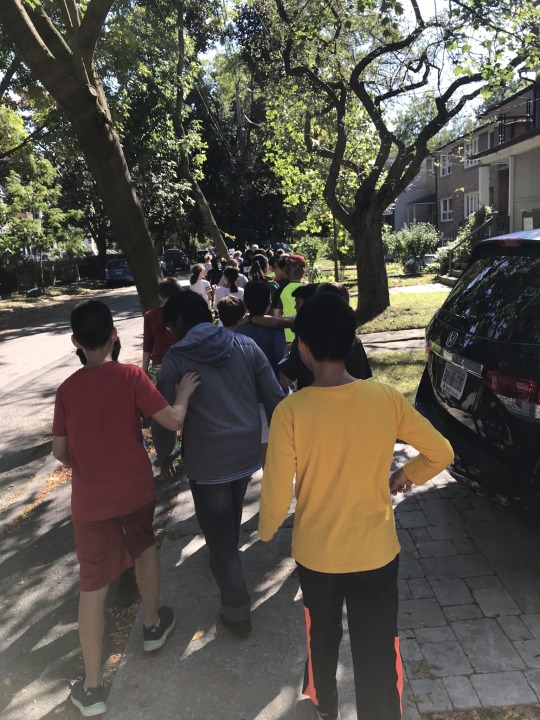
As we walked students chanted “If you’re like Terry HONK, HONK” and “HONK for Terry HONK, HONK!!” The support from the community was encouraging! Passerbyers cheered with us, high-fived, and told us to keep going to reach our end point. People in passing cars honked and cheered with us. Students connected with people in the greater community around their school. This day would not be possible without the help from the dedicated parent community and our Toronto Police Services. Thank you to this special team of volunteers who helped us celebrate this day in honour of Terry Fox.




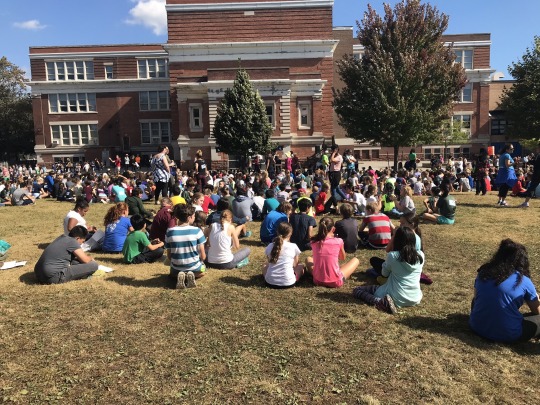


School spirits are high at Duke!
#terry fox#canadian hero#i am canadian#terry fox walk#walk for a cure#lets beat cancer#cancer awareness#duke#leslieville#community#duke of connaught#teacher#teacher's candidate#yorku#yorkEDU#education
0 notes
Text
Terry Fox’s latest contribution to cancer care: the Marathon of Hope Cancer Networks
The project just received a $150-million kick-start from the federal government – a single line in the March 19 federal budget that went largely unnoticed – and that will be matched dollar-for-dollar by the hospital partners
André Picard, The Globe and Mail
Friday, April 12, 2019
On April 12, 1980, 21-year-old cancer survivor Terry Fox dipped his prosthetic leg in the Atlantic Ocean near St. John’s to mark the beginning of an ambitious cross-country run to raise money for cancer research.
There was little fanfare when the Marathon of Hope began, but Terry’s odyssey began to generate media attention and, over weeks, months and years, his story gripped the nation, and the astonishing amount of money raised has left a mark on cancer research around the world through the numerous initiatives it has funded.
Thirty-nine years later, members of his family and the Terry Fox Foundation will return to the site of the first steps of the journey for a similarly low-key launch of what they hope will become another world-leading initiative.
The Marathon of Hope Cancer Networks is the name given to a grouping of leading cancer hospitals and research universities across Canada that will pool their resources to study and implement precision oncology. The networks will be overseen by the Terry Fox Research Institute, a group funded by the charitable foundation.
The project, which the foundation has had on the drawing board for years, just received a $150-million kick-start from the federal government – a single line in the March 19 federal budget that went largely unnoticed – and that will be matched dollar-for-dollar by the hospital partners.
Darrell Fox, Terry’s brother, said Terry’s dream was to see the work funded by the Marathon of Hope continue without him, and this is another great way to do so: “We are grateful to the millions of Canadians who have kept his dream alive and to the research and funding partners that are making this precision medicine network possible. You are bringing new hope to cancer patients.”
Precision oncology, simply stated, means customizing cancer treatments to individuals based on their genetic makeup and the molecular characteristics of their tumours. To do that, paradoxically, requires a lot of data from others: Patients’ genomes are decoded, their treatments are tracked and what is learned from the successes and failures goes back into refining treatments, a constant feedback loop that, theoretically, will result in much more precise and effective treatment.
“We’re committed to having the highest-quality data to ensure the highest-quality treatment for cancer patients,” Dr. Victor Ling, the president and scientific director of the Terry Fox Foundation, said in an interview.
The network’s researchers plan to decode the genomes of 15,000 cancer patients within the first five years, and 100,000 patients within a decade. The cancerous tumours of these patients would also undergo molecular profiling.
In addition, the network will gather, share and interpret data that have already been collected. “There’s a lot of useful information sitting in people’s laptops that needs to be shared more broadly,” Dr. Ling said.
He said one of the great advantages Canada has is a universal health-care system and specialized cancer-treatment centres, making it easy to track patients’ treatment from start to finish, and their outcomes over time. In the era of Big Data, that is crucial.
Opinion: Ontario’s response to the opioid crisis? Offer less help, and fewer answers
2019 Gairdner Awards: Winners hailed for discoveries on DNA replication and power of stem cells to fight cancer
Opinion: We’ve forgotten that vaccination isn’t just for kids
One of the key characteristics of the Marathon of Hope Cancer Networks is that it will be mandatory for researchers to collaborate across provincial borders. Five regional consortiums – B.C., Ontario, Quebec, the Prairies and Atlantic Canada – are expected to participate in the network once it’s fully operational.
Dr. Ling said the goal is to build the “Team Canada" of researchers that can play a prominent role on the international stage in this rapidly evolving field.
Although precision oncology is in its infancy, there are early, hopeful indications that knowing patient’s genetic variants can help avoid over- and underutilization of targeted cancer treatments. A typical example of this approach is the drug Herceptin, which is used to treat women with breast cancer, but only if they have a gene called HER2.
The data derived from genomic sequencing and molecular profiling should help identify other targets and help clinicians know, in advance, when and for whom specific treatments will or will not work.
The testing is getting increasingly affordable and available but projects such as this cost hundreds of millions of dollars because of the highly-trained individuals needed to do the analysis and interpretation that ultimately benefits patients.
“This network is about Big Data and artificial intelligence,” Dr. Ling said. “But, above all, it’s about investing in real intelligence to figure out what to with it.”
0 notes